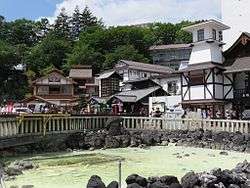Kusatsu, Gunma
| Kusatsu 草津町 | |||
|---|---|---|---|
| Town | |||
|
Yubatake hot spring in the center of Kusatsu | |||
| |||
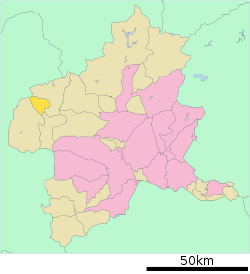 Location of Kusatsu in Gunma Prefecture | |||
 Kusatsu
| |||
| Coordinates: 36°37′14.5″N 138°35′45.9″E / 36.620694°N 138.596083°ECoordinates: 36°37′14.5″N 138°35′45.9″E / 36.620694°N 138.596083°E | |||
| Country | Japan | ||
| Region | Kantō | ||
| Prefecture | Gunma Prefecture | ||
| District | Agatsuma | ||
| Area | |||
| • Total | 49.75 km2 (19.21 sq mi) | ||
| Population (February 2015) | |||
| • Total | 6,537 | ||
| • Density | 131/km2 (340/sq mi) | ||
| Time zone | Japan Standard Time (UTC+9) | ||
| - Flower | Rhododendron subg. Hymenanthes | ||
| Phone number | 0279-88-0001 | ||
| Address | 28 Kusatsu, Kusatsu-machi, Agatsuma-gun, Gunma-ken 377-1792 | ||
| Website | Official website | ||
Kusatsu (草津町 Kusatsu-machi) is a town located in Agatsuma District of far western Gunma Prefecture in the northern Kantō region of Japan. As of February 2015, the town had an estimated population of 6,537 and a population density of 131 persons per km². Its total area was 49.75 km². Kusatsu is one of the most famous hot springs resorts in Japan,
Geography
Kusatsu is situated about 1,200 meters above sea level. The active volcano Kusatsu-Shirane (2,160 m) and the inactive Mount Tengu (1,385 m) and Mount Motoshirane (2,171 m) are located west of Kusatsu.
Climate
Due to the altitude Kusatsu's annual average temperature is 7 °C, with a maximum temperature of around 30 °C during summer and a minimum temperature of -14 °C in winter. The main rainy season is from June to September. During the winter season the streets are kept free of snow using onsen water.
| Climate data for Kusatsu | |||||||||||||
|---|---|---|---|---|---|---|---|---|---|---|---|---|---|
| Month | Jan | Feb | Mar | Apr | May | Jun | Jul | Aug | Sep | Oct | Nov | Dec | Year |
| Average high °C (°F) | −0.5 (31.1) |
0.1 (32.2) |
4.1 (39.4) |
11.3 (52.3) |
16.6 (61.9) |
19.3 (66.7) |
22.9 (73.2) |
24.0 (75.2) |
19.5 (67.1) |
14.1 (57.4) |
8.7 (47.7) |
3.0 (37.4) |
11.9 (53.4) |
| Daily mean °C (°F) | −4.2 (24.4) |
−3.9 (25) |
−0.6 (30.9) |
6.0 (42.8) |
11.1 (52) |
14.7 (58.5) |
18.5 (65.3) |
19.5 (67.1) |
15.4 (59.7) |
9.5 (49.1) |
4.1 (39.4) |
−1.1 (30) |
7.4 (45.3) |
| Average low °C (°F) | −7.9 (17.8) |
−7.8 (18) |
−4.7 (23.5) |
1.2 (34.2) |
6.3 (43.3) |
10.9 (51.6) |
15.1 (59.2) |
16.1 (61) |
12.1 (53.8) |
5.6 (42.1) |
0.3 (32.5) |
−4.7 (23.5) |
3.6 (38.5) |
| Average precipitation mm (inches) | 60.8 (2.394) |
71.3 (2.807) |
92.1 (3.626) |
103.9 (4.091) |
150.4 (5.921) |
213.6 (8.409) |
265.2 (10.441) |
239.0 (9.409) |
262.3 (10.327) |
134.6 (5.299) |
64.7 (2.547) |
54.7 (2.154) |
1,728.7 (68.059) |
| Average snowfall cm (inches) | 169 (66.5) |
161 (63.4) |
147 (57.9) |
38 (15) |
0 (0) |
0 (0) |
0 (0) |
0 (0) |
0 (0) |
0 (0) |
8 (3.1) |
115 (45.3) |
638 (251.2) |
| Source #1: 気象庁[1] | |||||||||||||
| Source #2: 気象庁[1] | |||||||||||||
Surrounding municipalities
History
Yayoi period
The legendary origin of Kusatsu goes back to the second century during the Yayoi period. According to the legend, either Yamato Takeru or Yamabushi discovered the hot springs around Kusatsu; however, there is no historical evidence for either claim. Per legend, Yamato Takeru named Tsumagoi and Agatsuma after his wife ("tsuma" means "wife" in Japanese).
Kamakura period
Up to the 12th century there is no specific record of Kusatsu. Local folklore recounts that Minamoto Yoritomo came to Kusatsu in 1193 in pursuit of fleeing Taira clan warriors. He then bathed in the Yubatake. The Gozaishi (御座石, illustrious seat, royal seat) on which Yoritomo sat, and the Yoritomo-gū (頼朝宮, Yoritomo Palace) in which he is said to have bathed, still exist. Kusatsu's history began in 1200 when the temple of Kōsenji was founded.
Sengoku period
Almost 400 years later, during the Sengoku period, there is more evidence for the existence of Kusatsu, which had grown into a hot-springs resort popular with wounded samurai. The Tokyo University Historiographical Book of Facsimiles (東大史料編纂所影写本 Tōdai shiryō hensanjo eishabon) contains correspondence during the year 1595 (Bunroku 4) between Tokugawa Ieyasu and Toyotomi Hideyoshi in which Hideyoshi recommended the Kusatsu hot springs to Ieyasu. The latter however, did not go to Kusatsu himself, but sent some servants to fetch some water from Kusatsu instead.
Edo period
During the Edo period, especially the Bakumatsu period, Kusatsu experienced unprecedented economic growth and became one of Japan's best-known hot springs. This was partly due to the increasing incidence of venereal diseases like gonorrhoea and syphilis, contracted in Tokyo red light districts like Yoshiwara, for which there was then no known cure besides bathing in a hot spring. The saying: "Kusatsu sengen Edo gamae" (草津千軒江戸構え) also goes back to this time and means: a thousand stores, just like in (the shopping districts in) Edo.

Hearing the praise of the Kusatsu Onsen the 8th Shogun Tokugawa Yoshimune had hot-spring water drawn from the Yubatake source and transported into his castle for bathing. The area of present-day Kusatsu was part of the hatamoto-administered territory within Kōzuke Province during the Edo period.
Meiji period
In 1869, Kusatsu burned to the ground. The town was reconstructed within a few years, but the process left many local people in debt, causing the bankruptcy of many small enterprises, especially ryokan, over the next 20 years. At that time many of the inhabitants of Kusatsu abandoned the traditional practice of "Fuyuzumi" (冬住み), which meant leaving Kusatsu in wintertime and returning to their hometowns, located further down the mountains. Instead, the townspeople sold their old homes to repay their debts and began to live in Kusatsu all year long.
Kusatsu Village was created within Agatsuma District of Gunma Prefecture on April 1, 1889 by the merger of former Kusatsu with Maeguchi and six other hamlets, with the creation of the municipalities system after the Meiji Restoration. On July 1, 1900 the former Kusatsu and Maeguchi portions of the village was raised to town status, and the remaining portion formed Kuni village.
The infrastructure developed in the Meiji period and also people`s knowledge, therefore many famous people were visiting Kusatsu. Especially foreigners were scientifically interested in this area, which became an important area for research of effects of hot springs, volcanoes etc.
In 1876, Erwin Bälz, a German internist came to Kusatsu for the first time. Bälz was one of the fathers of modern western medical science in Japan and court physician to Emperor Meiji. He was convinced of the healing power of the hot springs in Kusatsu, and began scientific research into them with a view to convincing the townspeople of the need to teach the correct application of the hot springs to Japanese medical doctors.
Taishō to Heisei
In 1914, the Kusatsu ski club was founded.
The year 1915 saw the first visit of British Anglican missionary, Mary Cornwall Legh. In 1916 Cornwall Legh using her own funds established the St. Barnabas' Mission, providing residential care facilities to the sizable population of Hansen's Disease sufferers then present in the Yunosawa area of Kusatsu. Cornwall Legh devoted her remaining years to the care of the Kusatsu leprosy community, her work and dedication to this cause recognized with honors by the Japanese Government.[2]
In 1941 the St. Barnabus' Hospital was closed, replaced by the, subsequently notorious, government run Kuryu Rakusen-en Sanatorium. St. Barnabus' Church and Cornwall Legh Park in Kusatsu attest to the charitable legacy of Mary Cornwall-Legh and the history of the community she sought to serve.[3]
In 1926, the construction of the Kusakaru railway line (草軽電気鉄道 Kusakaru denki tetsudō) between Kusatsu and Karuizawa, which had been begun in 1908 was finished.
In 1948, a ski lift was erected on Mount Tengu, near Kusatsu. It was the first ski lift in Japan, with Kusatsu going on to become one of the country's first proper ski resorts.
In 1964, rail services to the town ceased after the closure of the nearby sulfur pit and the ensuing loss of freight traffic, which made operation of the line uneconomic.
Economy
The town's main income is tourism (about 90% of the working population is employed in the tertiary sector), primarily in connection with its hot spring resorts, with very little industry and almost no agriculture.
Education
- Kusatsu Middle School
- Kusatsu Elementary School
Transportation
- Kusatsu has no train connections at present.
Highway
Sister city relations
 - Hayama, Kanagawa, Japan, since March 29, 1969
- Hayama, Kanagawa, Japan, since March 29, 1969 - Kusatsu, Shiga, Japan, since September 8, 1997
- Kusatsu, Shiga, Japan, since September 8, 1997 Bietigheim-Bissingen, Germany since October 11, 1962. The town in which Kusatsu's benefactor Erwin Bälz was born. The contacts with this sister town are the most intensive. There is an annual student exchange.
Bietigheim-Bissingen, Germany since October 11, 1962. The town in which Kusatsu's benefactor Erwin Bälz was born. The contacts with this sister town are the most intensive. There is an annual student exchange. Neustift, Austria since March 21, 1986. Winter sports resort town. Contact established through the Austrian national ski team.
Neustift, Austria since March 21, 1986. Winter sports resort town. Contact established through the Austrian national ski team. Karlovy Vary (Karlsbad, Carlsbad), Czech Republic since May 20, 1992. Spa resort town, was compared with Kusatsu by Erwin Bälz.
Karlovy Vary (Karlsbad, Carlsbad), Czech Republic since May 20, 1992. Spa resort town, was compared with Kusatsu by Erwin Bälz. Snowy River, Australia since July 10, 1991. This town is located on the same latitude as Kusatsu, but in the southern hemisphere.
Snowy River, Australia since July 10, 1991. This town is located on the same latitude as Kusatsu, but in the southern hemisphere.
Local attractions
Kusasu Onsen
There are about 100 hot springs in Kusatsu with a total amount of about 34,000 liters water per minute pouring out of the ground. The water is sulfurous and acidic. The hot springs are said to help cure: arthralgia, stiff shoulders, paralysis, hardenings, bruises, sprains, chronic indigestion, hemorrhoids, chills, arteriosclerosis, burns, chronic gynecological disorders. The water from the natural hot springs is used not only for bathing but also for heating of the city's primary and secondary schools, the municipal welfare center, the streets during winter and many households, as well as for the municipal swimming pool.
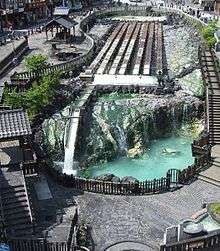 Yubatake
Yubatake
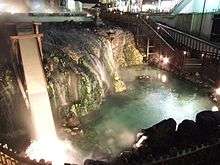
The Yubatake, one of the biggest hot springs and the main attraction of the town, is located in the center of Kusatsu. The spring water pours out of the rock and is then conducted through several rows of wooden boxes. In these wooden boxes Yu no hana (湯の花) one of Kusatsu's specialties is cultivated. The word Yubatake accordingly means "hot water field". Around the Yubatake there are 100 name plates of famous persons that visited Kusatsu. Internationally well-known are: Erwin Bälz (German internist), Julius Scriba (German surgeon), Bruno Taut (German architect), Ernest Satow (British researcher of Japan and diplomat), Kakuei Tanaka (Japanese prime minister 1972 - 1974), Rikidōzan (famous pro wrestler). On the lower part of the Yubatake there is a small cascade and the rock has an emerald shade. This is one of the most popular spots for souvenir pictures.

- Netsu no yu (熱の湯 lit. "hot water"), though located adjacent to the Yubatake, is a hot spring in its own right. The water is about 54 degrees Celsius, so it is not possible to bathe in it. For that reason there is the ancient tradition of Yumomi (湯もみ), which means kneading or bashing the water. Using 1.80 meter long wooden boards the hot water is stirred, bashed, kneaded and thus cooled down. The simpler method of pouring in cold water is not practiced as it would dilute the healing power of the water. During the Yumomi ceremony, the Kusatsu song is sung and Japanese traditional dance is performed.
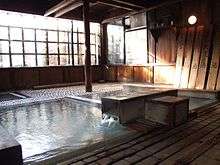
- Ōtaki no yu (大滝の湯, lit. "great waterfall hot spring") is named after spring water forming a waterfall. The building itself is made from wood and there is one basin on the inside and one on the outside (Rotenburo). Th

- Sai no kawara (西の河原 lit. "western riverbed") is an outside basin of approximately 500 ㎡, which can be used by more than 100 guests at once. There are separate baths for men and women divided by a wooden fence. Located in a valley overflowing with hot springs claims to be one of the most beautiful rotenburo of Japan.
- The Bälz Onsen Center, situated on a plateau near Mount Tengu ski area, offers great scenery and is a popular Après-ski recreation spot.
Bälz Museum
The Bälz Museum is another of Kusatsu's attractions. Located at the entrance to Kusatsu, visitors can inform themselves about the life and work of Erwin Bälz. There is also a souvenir shop with goods mostly from Germany and the Czech Republic.
Flowers
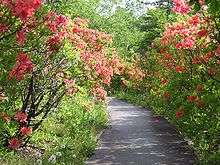
Another of Kusatsu's attractions are the mountain flowers growing in and around the city. The most famous are:
- Watasuge (Eriophorum Vaginatum, Hare's tail cotton grass)
- Zazensō (Simplocarpus foetidus, Skunk cabbage)
- Azumashakunage (Rhododendron Metternichii var. Japonica, a kind of Rhododendron)
- Hakusanshakunage (Rhododendron brachycarpum, a kind of Rhododendron)
- Rengetsutsuji (Rhododendron molle subsp. Japonicum, a kind of Azalea)
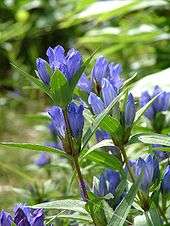
- Yanagiran (Epilobium angustifolium, Rosebay Willowherb)
- Nanakamado (Sorbus commixta, Japanese Rowan)
- Ezorindō (Gentiana triflora var. Japonica, blue Gentian)
- Komakusa (Dicentra peregrina, a kind of Magnolia)
Festivals and events

During the year there are a number of traditional festivals as well as a number of events.
- Kusatsu International Summer Music Academy & Festival, in late August, which attracts famous musicians from all over Japan and abroad, and is often attended by members of the Japanese Imperial Household.
- Kōsenji flower festival (光泉寺花祭り Kōsenji hanamatsuri) on 7–8 May. The children of the kindergarten near the Buddhist temple of Kōsenji pull an elephant made of paper around the Yubatake in celebration of Buddha's birthday.
- Ice-cave festival (氷室の節句 Himuro no Sekku) on the first of June. Ice is brought from a cave in Mt. Shirane, which was formed by an eruption of the volcano, and is used to make tea. According to folklore, anyone who drinks this special tea will not get ill in the following year.
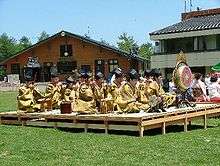
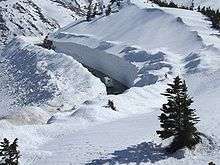
- Onsen gratitude festival (温泉感謝祭り Onsen kansha matsuri) held during the first three days of August. This traditional festival has its origins in the Ushiyu matsuri (丑湯祭り), which in accordance with the Chinese calendar is celebrated during the hottest time of the year on the day of the ox. According to the lore, those that bathe in an Onsen in the hour of the ox (one to three AM) will not get ill for one year. In contrast, today's ceremony is totally different: The goddess of Onsen descends the stairs at Kōsenji symbolizing the descent from heaven. She then gathers water from seven big hot springs in Kusatsu and distributes the water to the baths in Kusatsu. On the third day she ascends the stairs to Kōsenji, representing the ascent to heaven. Through this ceremony the blessing of the gods is granted, which will make sure that the springs won't run dry.
- Tour de Kusatsu (amateur bicycle race), Yuki no kairō walking (雪の回廊ウォーキング), (hiking through a valley of snow walls several meters high), soccer and skiing events.
Sports
The Thespakusatsu Gunma football club, although formed in and representing Kusatsu in the Japanese football league system, actually plays in Maebashi.
Souvenirs

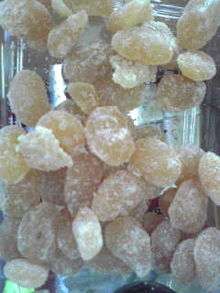
- Yu no hana ("hot water flower") is a powder extracted from the hot water at the Yubatake and consists of dried mineral sediment (mostly sulfur), which enable one to recreate the onsen waters at home.
- Amanattō (甘納豆) is a kind of sweet made of a special sort of highland beans, which does not bear fruit below 700 meters above sea level. First the beans are dried, then put into water and finally they are cooked in sugar. The details of the making process are a company secret.
- Manjū is a well-known Japanese sweet, consisting of a pastry crust made of flour, rice flour and buckwheat and a filling made of Azuki bean paste, and steamed using the steam rising from the hot springs.
Lakes and waterfalls
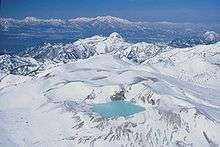
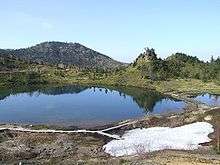
There are a number of waterfalls and crater lakes in the vicinity of Kusatsu. The most famous ones are:
- Yugama (湯釜) located 2,100 meters above sea level is the crater lake of Mount Shirane. It boasts a very high acidity and an emerald-green surface.
- Yumiike (弓池, lit. "bow lake"), 2,000 meters above sea level is located between Mount Shirane and Mount Motoshirane. Its water is crystal clear.
- Ōsen no taki (嫗仙の滝) and the Jōfu no taki (常布の滝) are waterfalls near Kusatsu.
Ski area
The Kusatsu international ski area (草津国際スキー場 Kusatsu kokusai sukijō) on Mount Tengu and Mount Shirane is over 90 years old and is one of the main attractions of Kusatsu. The ski area extends from 2,100 meters to 1,300 meters above sea level. The snow quality is very good and there are ten different routes for all difficulty levels as well as twelve lifts. The longest route is eight kilometers long.
Noted people from Kusatsu
- Kenji Ogiwara – Olympic gold medalist ski jumper
- Tsugiharu Ogiwara – Olympic gold medalist skier
- Ichita Yamamoto – politician
References
- Kawaai Yūtarō, Onsenshiwa, 1966, Gunma-ken, Agatsuma-Gun, Kusatsu-Machi, 3-7-2 Shigehara
- Kusatsu Kyōikuiinkai, Kusatsuonsen no Bunkazai, 1998, Asahiinsatsukōgyō Kabushikigaisha
- Erwin von Bälz Museum, director Okitsu Hiroyoshi, Toki No Utsuroi (not published)
- Kazumine Daiji, Manga Kusatsumachishi, 2000, Kusatsumachi
- Kusatsu Ryokankyōkai, Meiyukusatsu Onsen Hyakka
- Kusatsu Kankō Kyōkai, Kusatsu Style, 2007
- Kusatsu municipal business division, Kusatsu – The Kusatsu Guide 2002 (edited 2007)
- Kusatsu municipal tourism division, Kusatsu – Kusatsu tourism index
- Kusatsu town hall, special project division, Yubatake VIPs – 100 famous people that visited Kusatsu, 1999
Notes
- 1 2 "平年値(年・月ごとの値)". 気象庁. Retrieved 2011-06-22.
- ↑ "Portrait of the Week". The Japan Society. The Japan Society, London, UK. Retrieved 16 July 2014.
- ↑ "Mother of Kusatsu". NSKK Newsletter. NSKK. Retrieved 19 July 2014.
External links
| Wikimedia Commons has media related to Kusatsu, Gunma. |
-
 Kusatsu travel guide from Wikivoyage
Kusatsu travel guide from Wikivoyage - Official website (Japanese)
